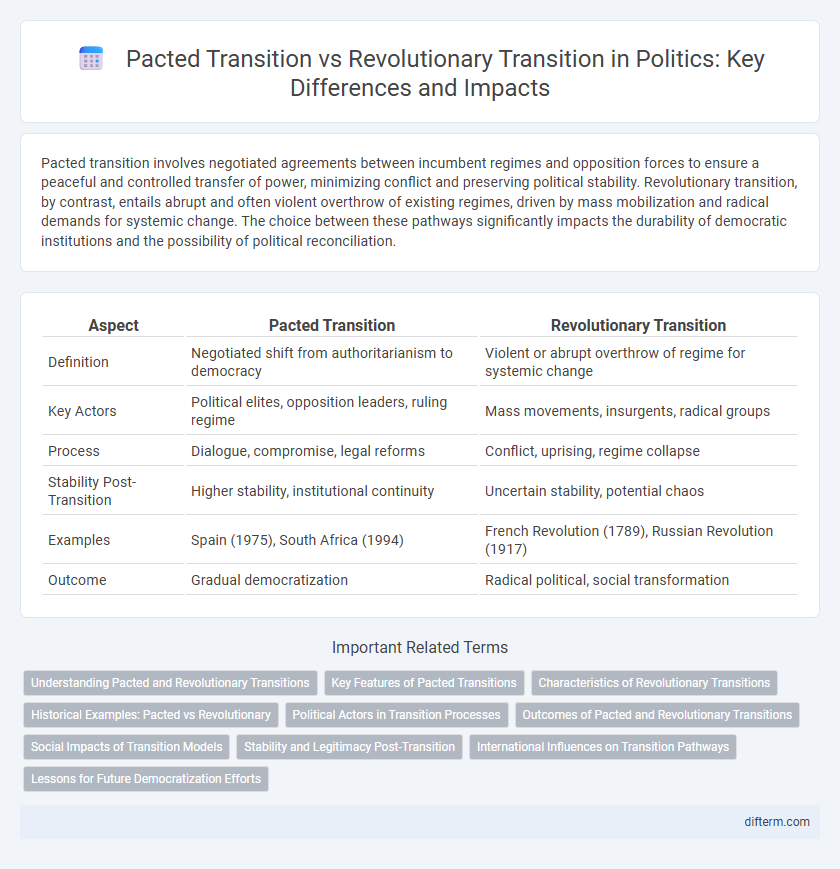Pacted transition involves negotiated agreements between incumbent regimes and opposition forces to ensure a peaceful and controlled transfer of power, minimizing conflict and preserving political stability. Revolutionary transition, by contrast, entails abrupt and often violent overthrow of existing regimes, driven by mass mobilization and radical demands for systemic change. The choice between these pathways significantly impacts the durability of democratic institutions and the possibility of political reconciliation.
Table of Comparison
| Aspect | Pacted Transition | Revolutionary Transition |
|---|---|---|
| Definition | Negotiated shift from authoritarianism to democracy | Violent or abrupt overthrow of regime for systemic change |
| Key Actors | Political elites, opposition leaders, ruling regime | Mass movements, insurgents, radical groups |
| Process | Dialogue, compromise, legal reforms | Conflict, uprising, regime collapse |
| Stability Post-Transition | Higher stability, institutional continuity | Uncertain stability, potential chaos |
| Examples | Spain (1975), South Africa (1994) | French Revolution (1789), Russian Revolution (1917) |
| Outcome | Gradual democratization | Radical political, social transformation |
Understanding Pacted and Revolutionary Transitions
Pacted transitions involve negotiated agreements between political elites to ensure stable power sharing, often preventing violent conflict and enabling gradual democratic reforms. Revolutionary transitions arise from mass mobilizations and radical upheavals, leading to abrupt regime changes that can result in uncertain political outcomes and social disruption. Analyzing these transition types reveals the trade-offs between stability and rapid transformation in political development.
Key Features of Pacted Transitions
Pacted transitions are characterized by negotiated agreements between ruling elites and opposition groups to ensure a peaceful transfer of power and prevent violent conflict. These agreements often involve compromises on political reforms, power-sharing arrangements, and guarantees for minority rights to stabilize the political environment. Central to pacted transitions is the emphasis on institutional continuity and gradual democratization rather than abrupt systemic change.
Characteristics of Revolutionary Transitions
Revolutionary transitions are characterized by rapid, often violent overthrow of existing political regimes, driven by mass mobilization and radical demands for systemic change. These transitions typically involve widespread social upheaval, the dismantling of established institutions, and the emergence of new power structures through confrontational means. Revolutionary transitions differ from pacted transitions by rejecting elite negotiation, favoring insurgency and direct action to achieve transformative political goals.
Historical Examples: Pacted vs Revolutionary
South Africa's pacted transition from apartheid to democracy exemplifies negotiated settlements ensuring stability and gradual reforms, contrasting sharply with the Cuban Revolution, where a revolutionary transition led to abrupt regime change and extensive social restructuring. Eastern Europe's post-communist countries experienced pacted transitions characterized by elite negotiations, while the Iranian Revolution of 1979 was a revolutionary transition marked by mass uprisings and radical regime overthrow. These historical examples highlight the varying outcomes in governance, social order, and international relations depending on the transition type.
Political Actors in Transition Processes
Political actors in pacted transitions engage in negotiated compromises to ensure stability and gradual reform, often involving elites from the outgoing and incoming regimes. Revolutionary transitions feature mass mobilization and confrontational actors seeking rapid and fundamental changes to existing political structures. The agency and strategies of these actors critically shape the trajectory and outcomes of the transition process.
Outcomes of Pacted and Revolutionary Transitions
Pacted transitions often result in stable democratic institutions, gradual political reforms, and reduced violence due to negotiations among elite actors. Revolutionary transitions tend to produce rapid systemic changes but can lead to political instability, authoritarianism, or prolonged conflict. Empirical studies show that pacted transitions have higher success rates in consolidating democracy compared to revolutionary upheavals.
Social Impacts of Transition Models
Pacted transitions often lead to more stable social structures by facilitating negotiated compromises among elites, reducing the risk of violent conflict and fostering gradual reform. Revolutionary transitions tend to generate significant social upheaval, disrupting established institutions and frequently resulting in radical redistribution of power and resources. The social impact of transition models directly influences long-term political legitimacy and societal cohesion.
Stability and Legitimacy Post-Transition
Pacted transitions often ensure political stability and legitimacy by involving key stakeholders in negotiated agreements, reducing the likelihood of conflict and fostering broad acceptance of the new regime. Revolutionary transitions may lack this consensus, leading to potential instability and contested legitimacy due to abrupt power shifts and exclusion of significant groups. Stability in pacted transitions derives from institutional continuity, while revolutionary changes risk upheaval but can swiftly dismantle entrenched systems.
International Influences on Transition Pathways
International influences significantly shape both pacted and revolutionary transitions by affecting the strategies and legitimacy of competing actors. Pacted transitions often benefit from diplomatic support and conditional aid aimed at gradual reform, while revolutionary transitions may be intensified or suppressed based on foreign ideological backing or economic sanctions. The geopolitical interests of major powers and regional organizations frequently determine whether external actors promote negotiation, intervention, or support for regime change, altering domestic power dynamics.
Lessons for Future Democratization Efforts
Pacted transitions emphasize inclusive dialogue and negotiated compromises between ruling elites and opposition forces, fostering political stability and gradual reform. Revolutionary transitions often result in rapid regime change but risk instability, authoritarian relapse, or social fragmentation without institutional safeguards. Future democratization efforts benefit from balancing conflict resolution mechanisms with strong institutions that ensure accountability, political inclusiveness, and sustainable governance.
pacted transition vs revolutionary transition Infographic

 difterm.com
difterm.com